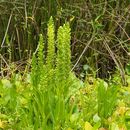Comments
provided by eFloras
Habenaria repens is remarkable in sometimes being truly aquatic. Often forming floating mats, the plants then are commonly decumbent, at least basally, and new shoots and slender roots arise abundantly from much of the length of the stem. A few spheroid tuberoids are sometimes produced from roots arising at wide intervals. Other roots bear new shoots some decimeters from the parent stem; the distal portion of the root then commonly enlarges into a slenderly lance-fusiform tuberoid.
- license
- cc-by-nc-sa-3.0
- copyright
- Missouri Botanical Garden, 4344 Shaw Boulevard, St. Louis, MO, 63110 USA
Description
provided by eFloras
Plants terrestrial or semiaquatic, erect to decumbent, 10–90 cm. Leaves scattered along stem and gradually reduced to sheathing bracts; blade ascending, linear-lanceolate to lanceolate, narrowly elliptic, or oblanceolate, 3–25 × 1–4.5 cm. Inflorescences: floral bracts spreading to ascending, lanceolate, 15–90 × 5–12 mm. Flowers ascending, not showy; sepals 3–7 × 3–4 mm; dorsal sepal shallowly concave; lateral sepals reflexed-spreading; petals greenish, lamina ascending, falcate, 3–7 × 1 mm, lateral lobe arcuately spreading-ascending, filiform, slightly to markedly exceeding petal; lip greenish, middle lobe descending, linear, 4–7 × 1 mm, lateral lobes ascending-spreading, filiform, 5–11 mm; spur slenderly cylindric to scarcely club-shaped, 0.8–1.4 cm; ovaries 9–15 mm. Capsules on short pedicel, nearly erect, 8–15 × 3–7 mm.
- license
- cc-by-nc-sa-3.0
- copyright
- Missouri Botanical Garden, 4344 Shaw Boulevard, St. Louis, MO, 63110 USA
Distribution
provided by eFloras
Ala., Ark., Fla., Ga., La., Miss., N.C., Okla., S.C., Tex.; Mexico; West Indies; Central America; South America.
- license
- cc-by-nc-sa-3.0
- copyright
- Missouri Botanical Garden, 4344 Shaw Boulevard, St. Louis, MO, 63110 USA
Flowering/Fruiting
provided by eFloras
Flowering primarily summer--fall, sporadically (Apr--Dec).
- license
- cc-by-nc-sa-3.0
- copyright
- Missouri Botanical Garden, 4344 Shaw Boulevard, St. Louis, MO, 63110 USA
Habitat
provided by eFloras
Marshes, wet meadows, bogs, margins of streams, ditches, and ponds; commonly an emergent aquatic in shallow water and in floating mats alone or with other vegetation; 0--100m.
- license
- cc-by-nc-sa-3.0
- copyright
- Missouri Botanical Garden, 4344 Shaw Boulevard, St. Louis, MO, 63110 USA
Synonym
provided by eFloras
Habenaria nuttallii Small
- license
- cc-by-nc-sa-3.0
- copyright
- Missouri Botanical Garden, 4344 Shaw Boulevard, St. Louis, MO, 63110 USA
Habenaria repens: Brief Summary
provided by wikipedia EN
Habenaria repens, commonly called the water-spider bog orchid or the floating orchid, is an orchid species widespread across Latin America from Mexico and the West Indies south to Argentina, as well as in the Southeastern United States from Texas and Oklahoma east to Florida and the Carolinas plus an isolated population in Virginia.
A phenolic compound called habenariol can be found in H. repens. It acts as a feeding deterrent.
- license
- cc-by-sa-3.0
- copyright
- Wikipedia authors and editors

